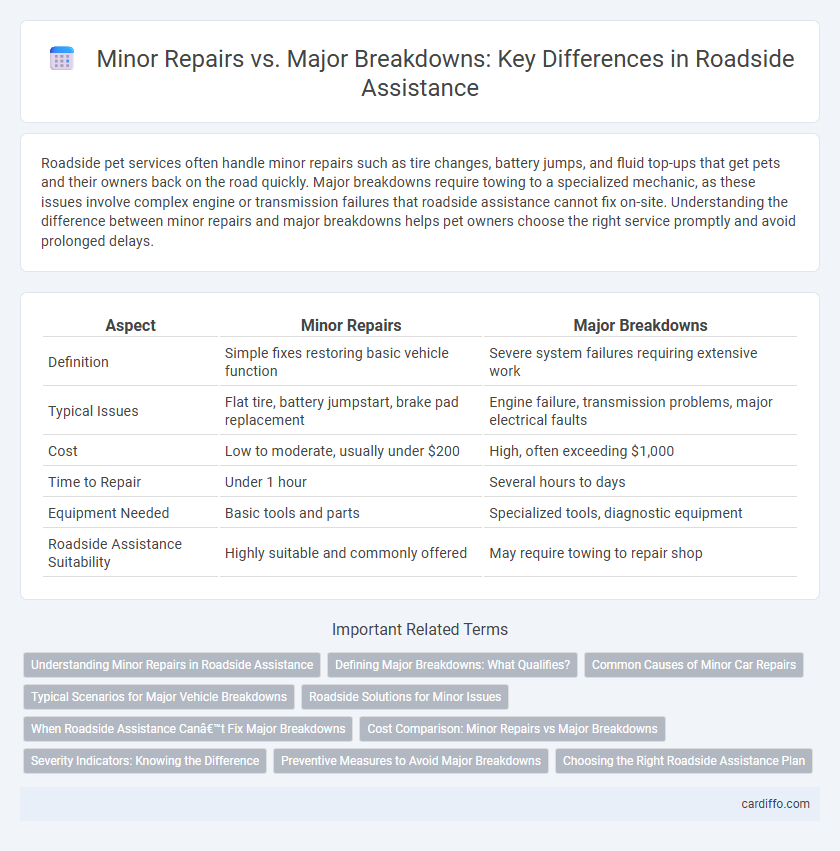Roadside pet services often handle minor repairs such as tire changes, battery jumps, and fluid top-ups that get pets and their owners back on the road quickly. Major breakdowns require towing to a specialized mechanic, as these issues involve complex engine or transmission failures that roadside assistance cannot fix on-site. Understanding the difference between minor repairs and major breakdowns helps pet owners choose the right service promptly and avoid prolonged delays.
Table of Comparison
| Aspect | Minor Repairs | Major Breakdowns |
|---|---|---|
| Definition | Simple fixes restoring basic vehicle function | Severe system failures requiring extensive work |
| Typical Issues | Flat tire, battery jumpstart, brake pad replacement | Engine failure, transmission problems, major electrical faults |
| Cost | Low to moderate, usually under $200 | High, often exceeding $1,000 |
| Time to Repair | Under 1 hour | Several hours to days |
| Equipment Needed | Basic tools and parts | Specialized tools, diagnostic equipment |
| Roadside Assistance Suitability | Highly suitable and commonly offered | May require towing to repair shop |
Understanding Minor Repairs in Roadside Assistance
Minor repairs in roadside assistance typically include battery jump-starts, tire changes, fuel delivery, and fixing small mechanical issues that can be resolved on-site. These quick fixes prevent the need for costly and time-consuming towing or extensive repairs. Recognizing the difference between minor repairs and major breakdowns helps drivers access timely support, reducing vehicle downtime and enhancing road safety.
Defining Major Breakdowns: What Qualifies?
Major breakdowns are defined by severe mechanical failures that prevent a vehicle from operating safely or at all, such as engine failure, transmission issues, or complete electrical system shutdowns. These incidents typically require extensive repairs, specialized equipment, and professional intervention, distinguishing them from minor repairs that involve quick fixes like tire changes or battery jumps. Identifying a major breakdown early is crucial to avoid further damage and costly repairs.
Common Causes of Minor Car Repairs
Common causes of minor car repairs include worn brake pads, battery issues, and flat tires, which frequently occur during everyday driving conditions. Loose or damaged belts, small fluid leaks, and malfunctioning sensors also contribute to routine roadside repairs. Addressing these minor issues promptly prevents escalation into major breakdowns, ensuring vehicle reliability and safety.
Typical Scenarios for Major Vehicle Breakdowns
Major vehicle breakdowns typically occur during long-distance travel or extreme weather conditions, such as heavy rain or snow, leading to engine failure, battery depletion, or transmission issues. These scenarios often require professional roadside assistance to address complex mechanical faults that go beyond the scope of minor repairs like flat tires or dead batteries. Timely intervention in cases of overheating, brake system failure, or electrical malfunctions is critical to prevent further damage and ensure vehicle safety.
Roadside Solutions for Minor Issues
Roadside solutions for minor repairs typically involve quick fixes like tire changes, battery boosts, and fuel delivery, enabling drivers to resume their journey without extensive delays. These minor interventions often prevent escalation into major breakdowns, which require comprehensive towing or mechanical services and incur higher costs. Efficient roadside assistance services prioritize addressing minor issues on-site, reducing vehicle downtime and improving overall road safety.
When Roadside Assistance Can’t Fix Major Breakdowns
Roadside assistance excels in handling minor repairs such as flat tires, battery jumps, and fuel delivery, which typically require quick fixes on-site. Major breakdowns involving engine failure, transmission issues, or severe electrical problems often exceed the capabilities of roadside technicians and necessitate towing to a specialized repair facility. Understanding the limitations of roadside services ensures drivers seek appropriate help promptly, preventing further damage or safety hazards on the road.
Cost Comparison: Minor Repairs vs Major Breakdowns
Minor repairs on vehicles, such as tire patching or battery replacement, typically cost between $50 and $200, offering a quick and affordable solution to keep your car running smoothly. Major breakdowns involving engine or transmission failure can exceed $1,000, often requiring extensive labor and parts replacement that significantly increase expenses. Choosing timely minor repairs prevents costly major breakdowns, making routine maintenance a cost-effective strategy for vehicle owners.
Severity Indicators: Knowing the Difference
Minor repairs on the roadside typically involve small issues like tire punctures, loose bolts, or battery boosts, which can be quickly diagnosed and fixed without specialized tools. Major breakdowns, indicated by severe symptoms such as engine overheating, complete loss of power, or fluid leaks, require immediate professional intervention to avoid further damage or safety risks. Recognizing key severity indicators like persistent warning lights and unusual noises ensures appropriate response and minimizes downtime during roadside emergencies.
Preventive Measures to Avoid Major Breakdowns
Regular maintenance and minor repairs play a crucial role in preventing major breakdowns on the roadside. Timely oil changes, tire inspections, and brake checks help identify and fix small issues before they escalate into costly, time-consuming problems. Implementing preventive measures such as routine engine diagnostics and fluid top-ups significantly reduces the risk of unexpected vehicle failures during travel.
Choosing the Right Roadside Assistance Plan
Selecting the right roadside assistance plan depends on understanding the differences between minor repairs and major breakdowns, as minor repairs such as tire changes or battery jump-starts often require quick, on-the-spot services, while major breakdowns like engine failure need comprehensive towing and repair coverage. Comprehensive plans typically include benefits like 24/7 emergency assistance, extended towing distances, and repair cost subsidies, ensuring preparedness for severe situations. Evaluating vehicle reliability, driving frequency, and typical travel conditions helps tailor a roadside assistance plan that balances cost-effectiveness with adequate protection against both minor inconveniences and major mechanical failures.
Minor Repairs vs Major Breakdowns Infographic

 cardiffo.com
cardiffo.com